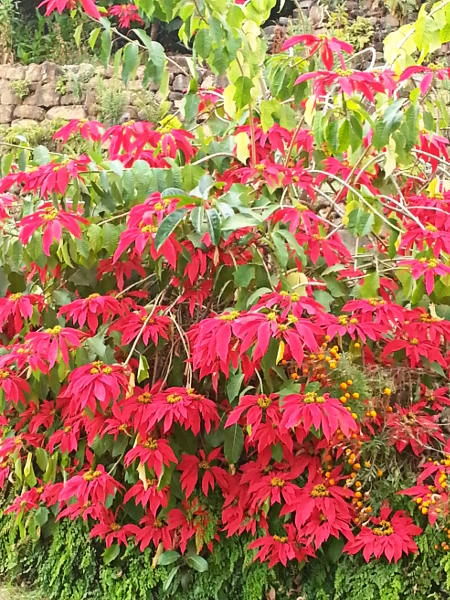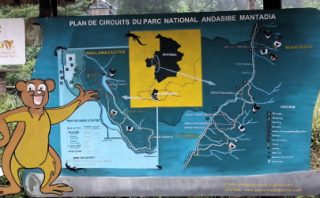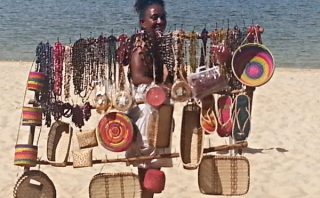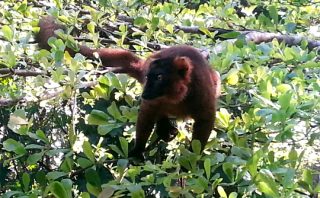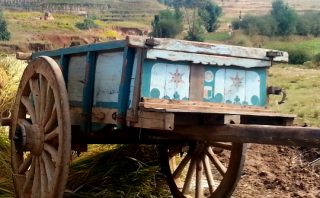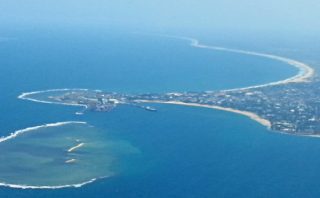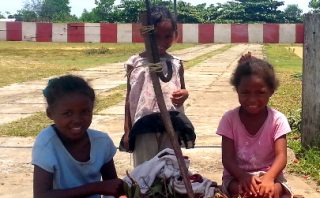Our guide, Isaiah, leads us through the gardens to the backside of Ambohimanga Rova. Antananarivo and the villages around it spread out below. There are something like three million people living down there. From up here, they seem pretty quiet. I locate Ivato International Airport in the distance and watch for awhile. The view would be great for watching the planes landing and taking off. But it’s quiet that direction as well.
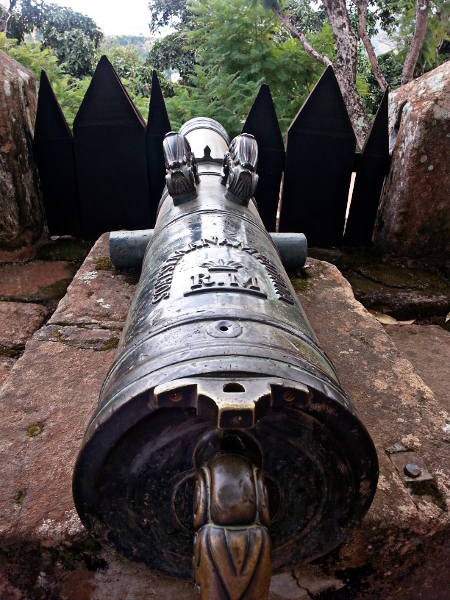
Ambohimanga. What a name. In Malagasy like in English, words are often formed from other words and sometimes the root words have more than one meaning. The Malagasy am means “at” and is a prefix used in forming place names. Vohitra means “hill.” Manga can mean “blue, sacred, excellent,” or “good” as an adjective and “mango” as a noun. Putting it all together, the v in vohitra becomes b and the tra gets dropped when combining with manga and we end up with ambohimanga, “at the blue hill” or “at the sacred hill.”
There are said to be twelve royal hills surrounding Antananarivo. I count more than twelve hills. I’m not sure which are royal and which aren’t. I’ve read that the number twelve is important to the Malagasy as it represents the number of unity. However many there are, the hilltops look blue in the distance because of the basalt rock exposed near their summits. Rova means “a fortified place.” So, I’m going with Ambohimanga Rova, “at the fortified blue hill.”
I know, enough of the language lesson already. Languages and etymology of place names are so intriguing.
The wind blows and rain threatens. Classes of school children on field trips keep up a constant chatter. Guides talk over the wind, school children, and tour groups.
For all that, it’s quiet on this blue hill above Antananarivo.
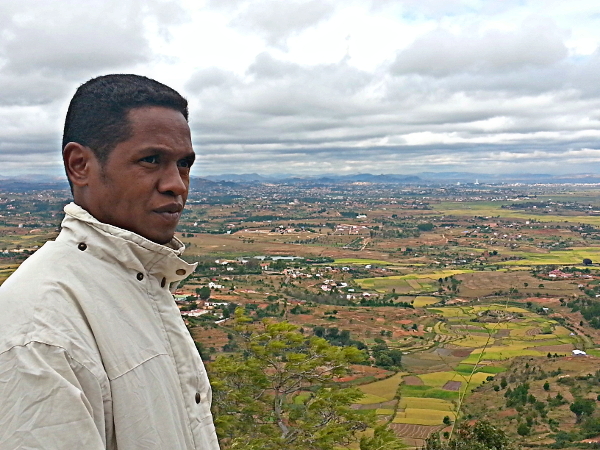
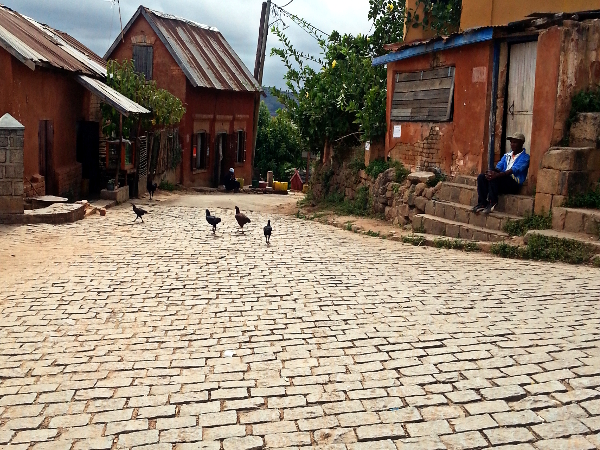
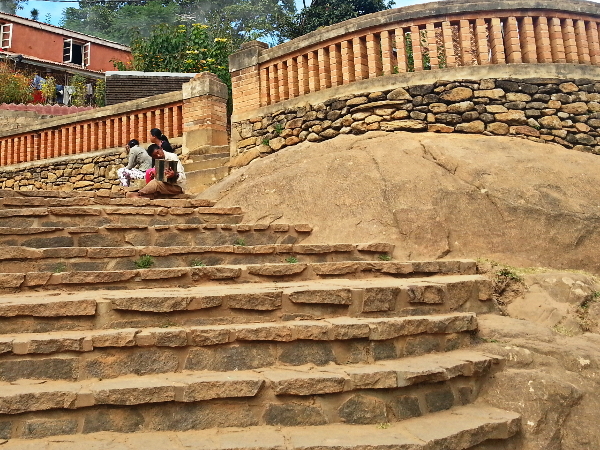
Ambohimanga Rova
Ambohimanga rises 1468 meters above sea level (about 4800 feet). Ambohimanga Rova covers 59 hectares (about 145 acres) of the hilltop and is comprised of a “royal city” surrounded by a system of fortifications with a series of ditches and moats and fourteen fortified stone gateways. Ambohimanga Rova also contains forest that is a vestige of the primary forest which originally covered the whole Malagasy central highlands.
There’s a personable story here about a small king of about 4 feet tall who would sit in the rafters so enemies couldn’t reach him and dropped pebbles on his wife to get her attention, of how this king had twelve wives and each had their own house on one of the twelve royal hills, and of how the guides have you walk backwards out of the king’s house because no one should turn their back to the king.
There’s a religious story here about pilgrimages, zebu (cattle) sacrifices, and the queen’s bathing ceremony which also marked the Malagasy new year.
There’s also an epic story here of the Kingdom of Madagascar unified under the Merina kings.
Madagascar has three United Nations Educational, Scientific and Cultural Organization (UNESCO) World Heritage sites. There used to be four. The Rainforests of Atsinanana and the Tsingy de Bemaraha Strict Nature Reserve are Madagascar’s two Natural Sites. Ambohimanga Rova is Madagascar’s only remaining Cultural Site. The other one, the Queen’s Palace in Antananarivo, burned down in 1995.
UNESCO describes Ambohimanga as “associated with strong feelings of national identity” and a “significant symbol of the cultural identity of the people of Madagascar.” I’ve read something similar in a number of travel sources. For some reason, this just doesn’t sit right with my experience of Madagascar.
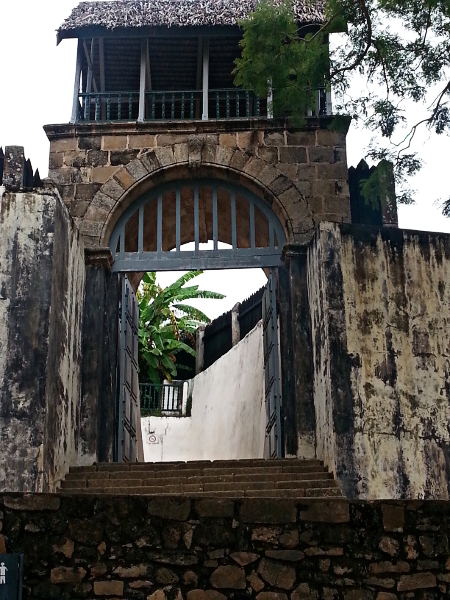
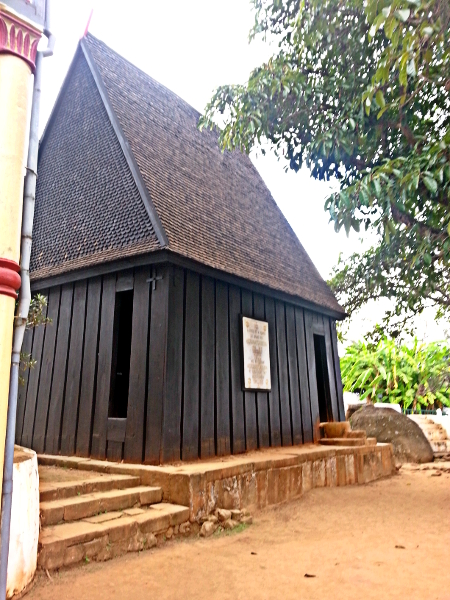
An Abbreviated Written Story
King Andriamasinavalona, the great grandfather of King Andrianampoinimerina, the small king who sat in the rafters, ruled over the Kingdom of Imerina from 1675-1710. In 1710, he divided the Kingdom into four quadrants and gave each quadrant to a favorite son to rule. He died a few months after this. The King’s intent was to strengthen the defenses of the kingdom. Instead, the opposite happened. His sons began a series of wars against each other to seize each other’s territories.
Avaradrano, the northern quadrant with its capital at Ambohimanga Rova, was given to Andrianampoinimerina’s grandfather, King Andriantsimitoviaminandriandrazaka, who ruled there from 1710-1730. Andrianampoinimerina’s father, King Andriambelomasina, ruled from 1730-1770 and his brother, King Andrianjafy, from 1770-1787.
By 1787, when King Andrianampoinimerina became King of Imerina Avaradrano, the Merina had suffered 77 years of civil war, famine, and attacks from the Sakalava and others mainly to capture slaves. This ended under King Andrianampoinimerina who reunified the Kingdom of Imerina between 1787-1800.
From around 1800, Andrianampoinimerina began a conquest of the rest of Madagascar. Some say he began an effort to unite Madagascar’s ethnic groups under his rule. Some credit Andrianampoinimerina as the originator of the notion of a unified Malagasy nation. Perhaps he came by concepts of nationalism from the French and British who were in the area expanding their influence and empires.
King Andrianampoinimerina sent a royal messenger bearing invitations to all the Malagasy kingdoms and tribes to become vassals under his sovereignty, or face a military conquest. Some complied. Others, like the Sakalava and Bezanozano, resisted. At the time of his death in 1810, Andrianampoinimerina had expanded the Merina kingdom, but was not successful in his desire to unite or conquer all of Madagascar.
Andrianampoinimerina’s son, King Radama I, carried on his father’s ambitions. With the support of the British, who recognized him as “King of Madagascar,” Radama reconquered the Betsileo, and defeated the Sakalava, Betsimisaraka, Antanoys, Antesaka, Tanala, and others. By 1827, Radama had united two-thirds of the island under Merina rule and forged the Kingdom of Madagascar. The Kingdom lasted until the 1895 invasion and subsequent colonization of Madagascar by France.
If history is written by the winners, then Abohimanga Rova as a center for the national and cultural identity of Madagascar makes sense.
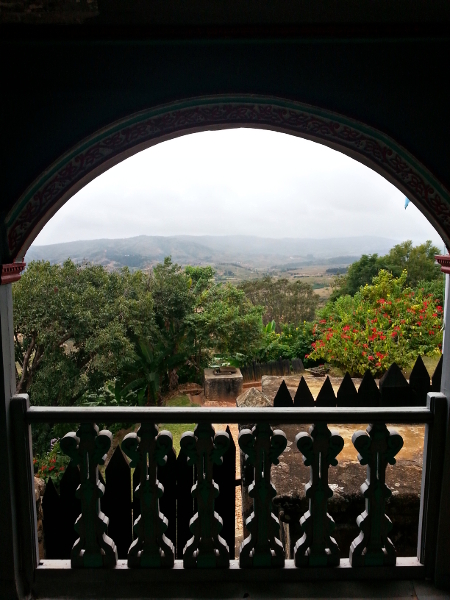
An Abbreviated Unwritten Story
Malagasy names are long. Did you notice? If you can suss it out, Malagasy names mean something. For example, one meaning given for Andrianampoinimerina is “the one who will always stay in the Merina’s hearts.” Another is “the king who is not like the stupid.”
Like Malagasy names, Madagascar’s story takes some sussing out, like finding the part of the story that hasn’t been written.
If you are Sakalava, Betsileo, Betsisimaraka or one of the other Malagasy ethnic groups that aren’t Merina, maybe Ambohimanga Rova doesn’t remind you of your national and cultural identity. Maybe Ambohimanga Rova reminds you of being conquered and dominated by the Merina during the rule of Andrianampoinimerina and Ramada I. Maybe Ambohimanga Rova reminds you of the continued concentration of power and wealth by the Merina under French colonial rule.
Not only are there 18 ethnic groups in Madagascar, there’s often a distinction made between the peoples of the highlands or central plateau and those of the coast. The coastal peoples, who are called côtiers, have long felt deprived of the education, power, and wealth that is concentrated in the highlands. I’ve sensed this. Talking with Malagasy friends about poverty, corruption, bad roads and such in Madagascar, I sense a distinction between the highland people and the rest of the country. During elections, there is definitely a sense of division, distrust, and even animosity between the people of the highlands and the rest of the country.
On a Blue Hill
Ambohimanga Rova’s tumultous story touches all Malagasy. It’s a defining story for the Merina. It’s a counterpoint story for the Antaifasy, Antaimoro, Antaisaka, Antambahoaka, Antakarana, Antanosy, Antandroy, Bara, Betsileo, Betsimisaraka, Bezanozano, Mahafaly, Sakalava, Sihanaka, Tanala, Tsimihety, and Zafisoro. There’s accord and discord.
For all that, it’s quiet on this blue hill above Antananarivo.
